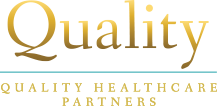Efficient Healthcare Operations
Quality Healthcare Partners (Quality) employs Lean Six Sigma and other process improvement techniques to enhance our clients’ efficiency of operations, quality of patient care, and bottom-line performance. Lean techniques have demonstrated conclusively that they are very effective at optimizing healthcare organizations, increasing accuracy, and reducing costs. Assessments can be performed at the department level, such as the emergency department or the clinical lab, and also at a broader level, such as the capture of patient care data as patients thread their way through the organization.
Here are examples of how lean-based assessments that can improve patient safety, boost quality, and increase profits:
- Revenue cycle process improvement
- Denial – appeals management improvement
- Emergency room throughput
- Outpatient revenue optimization
- Nursing rapid discharge improvement
- Utilization and revenue cycle system alignment improvement
- Lab Overutilization Process Improvement
- Diagnostic Overutilization Process Improvement
Lean Six Sigma is widely recognized as a best practice methodology for improving operations, quality of care, cost reduction, and is an outstanding return on investment.
Quality’s Lean-Based Services
While lean-based services can be leveraged across a broad range of organizational activities, the methodology employed is consistent for most projects. For example, Quality’s process improvement experts will:
- Work with organizational leadership to establish a process-improvement team consisting of key client personnel and the Quality lead consultant(s).
- Confer with the process-improvement team to explain the project approach, timeline, and team member roles.
- Submit a request for historical and current-state data, and provide the organization with tools to gather the data.
- Prepare graphical summaries of past and current state data relevant to work flow inefficiencies, errors, and lost opportunities (often presented in the form of value stream mappings, control charts, statistical tabulations).
- Conduct working sessions with the client personnel to assess the significance of the data and to identify the areas of inefficiencies and errors.
- Guide the process-improvement team in performing root-cause analyses and identifying potential counter measures.
- Advise the client team in implementing countermeasures in accordance with the greatest potential benefits – such as altering workflows, making improvements in data capture forms, simplifying the physical environment.
- Recommend implementing more complicated counter measures as separate projects (e.g., major IT changes, equipment changes, facility redesigns).
- Guide the process-improvement team in activating the appropriate counter measures. Ensure that the operational staff understands the new changes and their rationale prior to implementing the cutover.
- Provide updated process documentation, if necessary.
- Advise the process-improvement team on measuring and monitoring results to include gathering data and using control charts to display key performance indicators with boundary limits.
- Verify that the changes produced stable improvements.
Prior to the conclusion of the engagement, Quality will assist the client in formalizing the recommended changes so that they are adhered to consistently going forward. Generally, this involves updating policies, procedures, and work forms so that the changes become a permanent way of doing things. Quality’s team will also advise the client on how to monitor the enhanced processes and how to gather data to ensure that the improvements will continue to sustain themselves.
Quality’s Credentials and Client Experiences
Our process improvement experts are Lean Six Sigma certified and seasoned veterans of decades of improving healthcare operations. Each has performed process improvement projects across a broad spectrum of healthcare settings.
Benefits to Your Organization
- Lean Six Sigma and change management techniques will simplify, streamline, and optimize your organization’s performance.
- Once implemented successfully, you will be able to reuse the methodology to monitor progress and make additional improvements to the areas under study.
- With Lean Six Sigma it is possible to improve operations and quality of care while at the same time reducing costs.
